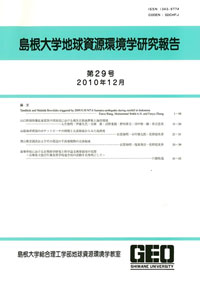島根大学総合理工学部地球資源環境学教室
ISSN:1343-9774

ダウンロード数 : ? 件
この文献の参照には次のURLをご利用ください : https://ir.lib.shimane-u.ac.jp/7332
島根大学地球資源環境学研究報告 28
2009-12-25 発行
島根県内における未利用砕石の有効活用の地質学的検討 : 浜田市(株)三隅興産採石場の流紋岩の例(予報)
Geologic examination of utility of waste material occurring with construction stone in Shimane Prefecture Japan : A case study of rhyolite from the Misumi Kosan Co. Ltd. Quarry, Hamadacity (Preliminary Report)
ファイル
内容記述(抄録等)
Rhyolite occurs in hornfelsed Sangun metamorphic rocks in the Misumi Kosan Co. Ltd. quarry in Shimokowa, Misumi town, Shimane Prefecture, Japan. Rhyolites in this area have not been used as construction stones because they are fragile compared to the dark hornfels which are the major resource of this quarry. Rhyolite, however, is widely used in Japan as a glaze for pottery. The Shimokowa rhyolite commonly contains pyrite grains produced by later hydrothermal activity. Iron concentrations (total Fe as Fe2O3) of the rhyolite from the Misumi Kosan quarry reach 5.02 wt%. After removal of pyrite grains, powdered rhyolite from the quarry contains only trace levels of iron and sulfur. The rhyolite can then be utilized as glaze powder. The mode of occurrence of rhyolite in the quarry and the geologic feature of the surrounding area are reported in this paper. Hornfelsed pelitic schists are widely distributed in the study area, and contain intercalated lenticular bodies of psammitic schist. Schistosity can be observed in the psammitic schist in the northern part, showing EW trend and gentle dip toward the north. The trends in the southern part of the study area are not concordant with this schistosity, and were deformed by faults. NE-SW trending rhyolites intrude the hornfels in many places in this area.
Other Article
PP. 51 - 63
